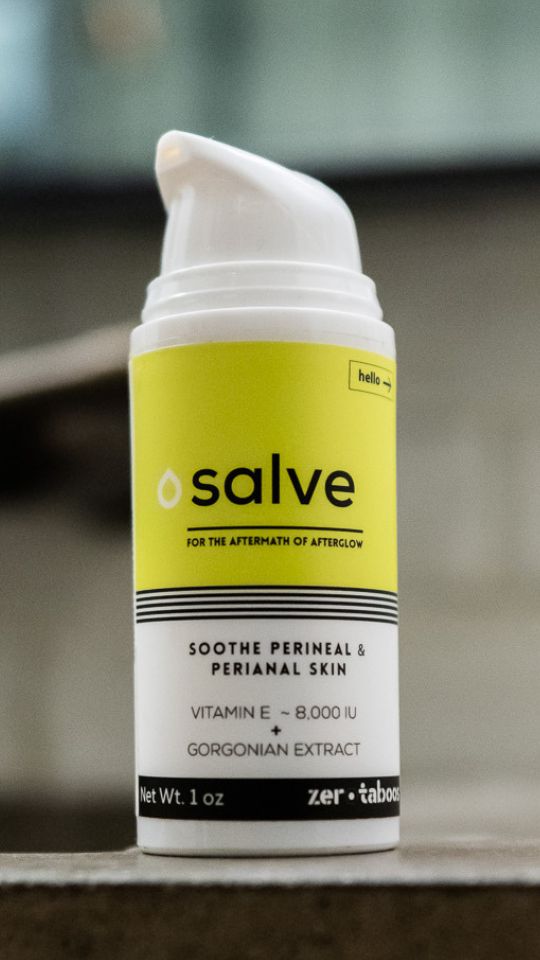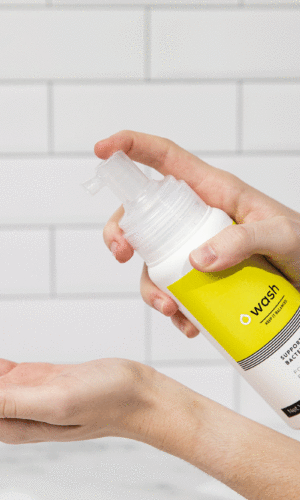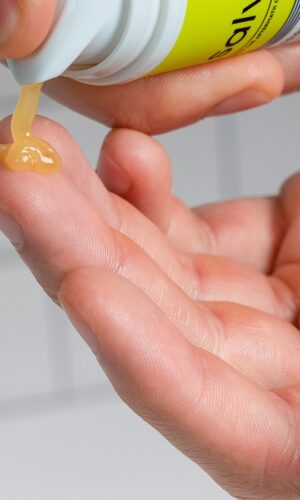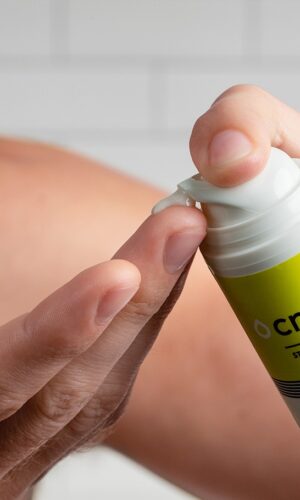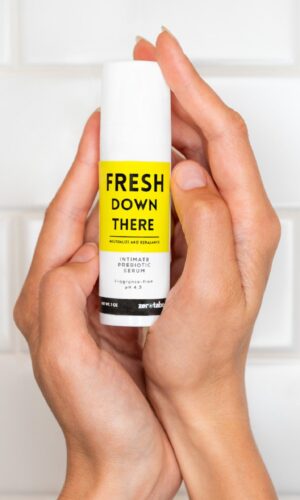
What is Vitamin E?
Vitamin E is an important nutrient, which benefits our vision, reproduction system, health of blood vessels, brain, skin, and other organs. It cannot be synthesized by the body, so we need to consume it in the form of food (RRR-alpha-tocopherol) or supplements (all-rac-alpha-tocopherol). Although vitamin E cannot be produced by the body, it can be stored in it and act as an antioxidant.
Antioxidants protect cells from free radical damage and reduce the production of free radicals. Free radicals are molecules that are produced when the body is exposed to radiation, air pollution, smoking, or industrial chemicals. These molecules can promote the development of cancer, cataract, cardiovascular and inflammatory disease, and other diseases.
Synthetic versus natural Vitamin E
Natural vitamin E is derived from vegetable oils (sunflower, canola, sesame). Synthetic vitamin E is produced from petroleum products. The main difference between them is the structure of their compounds.
Synthetic supplements are not as beneficial as natural vitamin E. According to Robert Acuff, Ph.D., Professor and Director of the Center for Nutrition Research at East Tennessee State University, natural vitamin E delivers at least twice the impact as synthetic, meaning that you will need 2 times more synthetic vitamin E than natural to equal its biological activity.
Some experts believe that lab-made vitamin E is less bioavailable than natural: due to its molecular structure, natural vitamin E is absorbed by the body better and stays in the body longer, having more time to get into the tissue where it is needed. Jack Challem, “The Nutrition Reporter”, wrote that specific binding and transport proteins produced in the liver select the natural d-alpha form of Vitamin E and largely ignore all other forms.
A quick trick on how to know if you are buying natural or synthetic vitamin E: the natural form has “d” (not “dl”) at the beginning and the word tocopherol ends with “ol” (not “yl”), thus:
d alpha-tocopherol is natural,
dl alpha-tocopheryl is synthetic.
Natural vitamin E we use in SALVE is derived from non-GMO canola, grown in the USA.
What is the difference between topical and oral Vitamin E?
Topical vitamin E is applied directly on the skin, and oral is taken in the form of capsules/pills. Topical vitamin E is mostly liquid. It is often presented in the form of vitamin E oil or as an ingredient in a vitamin E cream.
So which one is better, oral or topical? It depends on the purpose of why you use it. For example, a study during which oral mucositis was treated with vitamin E showed that its topical application had better results than systematic vitamin E treatment with pills. So if you need to treat a local problem on the skin or mucous membrane, topical vitamin E will be more effective. And how does vitamin E work on the skin? Keep reading.

Time's up
topical Vitamin E oil Benefits and mechanism of action
Due to its antioxidant properties, vitamin E is used for the treatment of many skin disorders:
- skin swelling;
- skin thickness;
- erythema;
- psoriasis;
- atopic dermatitis,
- edema;
- granuloma annulare;
- hyperpigmentation;
- even dark under-eye circles.
Most anti-aging creams contain vitamin E in the amount of 0.5%–1%. Topical vitamin E oil is used in the treatment of scars, burns, and wounds.
Vitamin E is fat-soluble and due to its lipophilic nature (which means it can dissolve in fat), topical vitamin E can penetrate underlying layers of skin, in particular, the stratum corneum (see the picture below). Topical vitamin E can be absorbed by the skin in large quantities and stored there.
A high concentration of vitamin E in the skin protects it from external irritants and damaging factors like UV radiation or environmental pollution. With the help of Vitamin E, the skin layers are supplied with sufficient moisture and the cells are filled with essential nutrients.
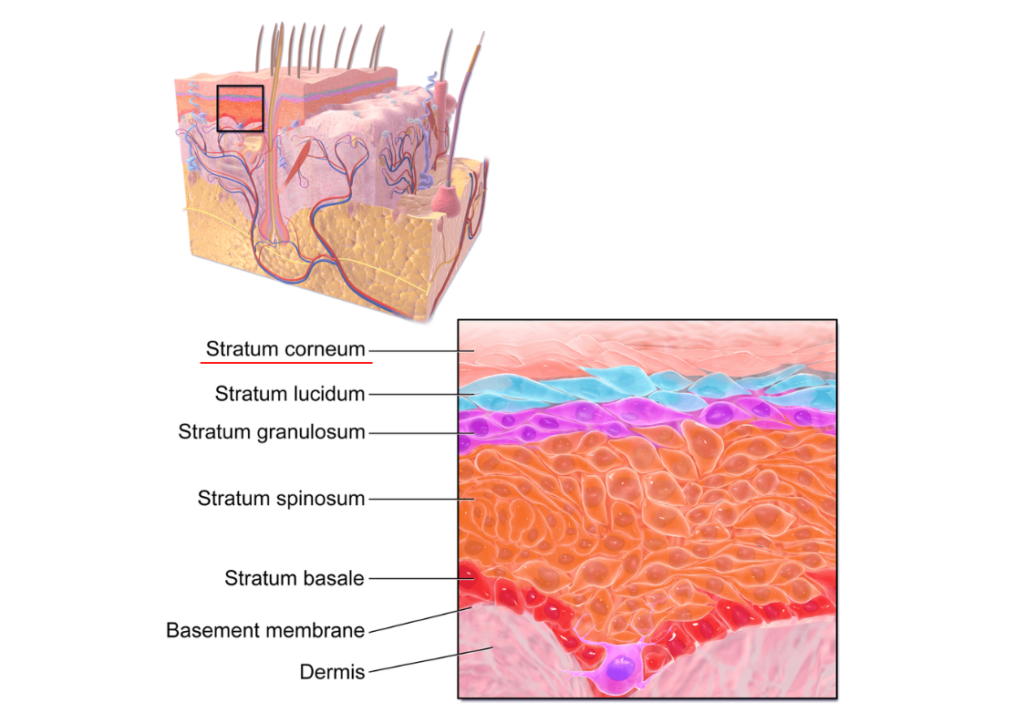
According to research, vitamin E levels in the dermis increase greatly after topical application, likely accumulating not only in the stratum corneum but in the sebaceous glands too.
When taken orally, vitamin E also accumulates in the sebaceous glands before it is delivered to the skin surface through sebum. Thus, vitamin E concentration is higher for people with oily skin, as more sebum is produced.
The difference is that after oral ingestion, it takes at least seven days before vitamin E is altered by sebaceous glands and reaches the stratum corneum. And when applied topically, vitamin E penetrates the skin right away.
Topical Vitamin E for hemorrhoids, mucosa, and wounds healing
You can apply vitamin E oil on hemorrhoids, fissures, anal skin tags, tears, and similar conditions in your perianal and perineal area.
The perineal area (or perineum) is the skin between the vagina and anus in women and the scrotum and anus in men. The perianal area refers to the skin surrounding the anus.
Hemorrhoids are swollen, enlarged veins in your anus and lower rectum. There are internal hemorrhoids, which occur in the lower rectum, and external hemorrhoids, which develop under the skin around the anus. Hemorrhoids can appear from increased pressure in the lower rectum, caused by frequent constipation or diarrhea, pregnancy, obesity, a low-fiber diet, regular heavy lifting, etc.
Anal fissures are small tears in the mucosa that lines the anus. Anal fissures occur when you pass hard or large stools during a bowel movement. They usually cause pain and bleeding with bowel movements.
Anal skin tags are benign skin growths around the anus, which are often caused by various pathologies like hemorrhoids and anal fissures.
As topical vitamin E improves blood circulation and helps to decrease inflammation, it will speed up the healing process of anal fissures and shrink the hemorrhoids. Massaging vitamin E oil on the anal skin tag will soften skin tags. Due to its antimicrobial properties, topical vitamin E helps reduce the number of bacteria present in the anus. Overgrowth of these bacteria can lead to infection and swelling.
Let us remind you, that when you have any of these conditions, you should keep your perianal area and anus clean. As wiping with dry toilet paper can be painful, and wet wipes contain too many chemicals, which make the skin more dry and irritated, you should wash the area with plain water if you can, or use a wiping gel, like WipeGel with prebiotics and witch hazel to refresh, soothe, and cool the area.
How do you apply Vitamin E oil to your anus?
- Clean the perianal area with water or a product containing witch hazel. Pat the skin dry.
- If you are using a vitamin E capsule, pierce it with a clean pin or needle and squeeze it. If you are using SALVE with 20% of natural vitamin E, pump a drop of it on your clean finger.
- Apply vitamin E directly on the hemorrhoids, anal fissure, or skin tag, using your finger to spread it evenly.
For the best result repeat twice daily.
There have been many studies conducted to see if vitamin E helps with wounds and cuts healing. Some of them confirm that vitamin E can promote wound healing due to its antioxidant properties, however, further research is necessary. So, there is not enough scientific evidence to be 100% certain that vitamin E can heal wounds on the skin.
Vitamin E oil is also used as a solution for healing mucosa. For instance, oral mucositis can be treated with vitamin E. And studies show, that topical application of vitamin E has better results than oral treatment.
Topical Vitamin E vs topical estrogen
65%–85% of women experience unpleasant symptoms of menopause.
During menopause, women go through hormonal changes, which include genitourinary syndrome (also known as vaginal atrophy) – symptoms caused by estrogen deficiency: vaginal dryness and discomfort, thinning of tissue, vulnerability to yeast overgrowth, urinary tract infections, recurrent vaginal infections.
It happens because women no longer produce the natural hormones that keep their pH acidic. Sufficient vaginal estrogen and the vaginal microorganism are directly connected. In response to estrogen, vaginal epithelial cells grow, their glycogen content is increased, and microorganisms (lactobacillus) produce lactic acid from glycogen, which causes an acidic pH and maintains the growth of beneficial bacteria. So, after menopause, when there is not enough estrogen produced, the vaginal pH rises.
There are hormonal and non-hormonal methods to improve vaginal atrophy. Hormonal methods include the systematic use of topical estrogen in low doses in the form of cream, vaginal ring, or vaginal tablet. Non-hormonal methods include lubricants, moisturizers, oils, including vitamin E oil, and vitamin E suppositories.
Only 20%–25% of women prefer hormonal treatment. Others look for a natural alternative. Being fat-soluble with antioxidant properties, vitamin E is involved in the metabolism of cells and prevents tissue damage caused by oxidants. Vitamin E opposes estrogen, meaning it is anti-estrogenic. It doesn’t mean it lowers estrogen, but it makes its level balanced and helps reduce the negative impacts. A study proved that postmenopausal women who used vitamin E suppositories had the same effect as those who used vaginal estrogen cream for relieving the symptoms.
Another study showed that vitamin E suppositories helped to decrease vaginal pH (the average pH before the treatment was 6.2, and after – 5.1). Normal vaginal pH ranges between 3.8 and 5.0, this pH level helps to promote the growth of healthy bacteria.
According to research, Vitamin E can gradually influence tissue recovery and decrease dyspareunia (painful intercourse) due to the healing of atrophic wounds in the lower urogenital system. No wonder vitamin E is sometimes called a “sex vitamin” – it is necessary for synthesizing hormones and hormone-like substances.
Excess estrogen is inflammatory and increases cortisol levels, thus, some people cannot use hormonal treatment due to health conditions. For them, Vitamin E oil or suppositories are the best option for relieving the symptoms of vaginal atrophy.
Is topical Vitamin E safe during pregnancy?
Vitamin E oil is not only safe to use on vagina, but it is also beneficial. Vitamin E oil is also good for pregnancy and postpartum. Here are some uses of vitamin E oil:
- It can be applied to the belly, breasts, and thighs to prevent stretch marks by moisturizing the skin and making it more elastic.
- Skin discoloration often occurs during pregnancy due to estrogen surge, stimulating hyperpigmentation. You can apply vitamin E oil or skin care products with vitamin E to problem areas to treat the discoloration. But mind the concentration of vitamin E, as in some cases its excessive concentration can irritate sensitive skin.
- Perineal massage with vitamin E oil is recommended after the 34th week of pregnancy to decrease the amount of tearing during childbirth, as vitamin E increases skin elasticity.
- If you had a C-section, you can apply vitamin E oil to your scar to heal it quicker.
- Massaging vitamin E oil on the labia is recommended after childbirth too, as it moisturizes and soothes the dry and irritated areas.
If you are wondering about the amount of topical vitamin E that should be applied, some products already include the perfect and safe concentration of vitamin E. For example, SALVE contains 20% of natural vitamin E and 5% of gorgonian extract and is designed specifically to use on the genital area. Gorgonian extract, also known as Sea Whip, is a powerful healing ingredient. It neutralizes enzymes responsible for irritation and helps to soothe and hydrate the skin.
During postpartum women often face soreness of nipples, but if you are breastfeeding it is not recommended to apply vitamin E oil on your breasts topically, as it can be toxic for a baby.
Vitamin E oil smell
Yes, vitamin E may have a scent. If a product with vitamin E has kind of a woody smell, you may be certain this product is concentrated. For example SALVE has 20% of vitamin E – it is 1/5 of the bottle. We decided not to mask the scent of vitamin E with fragrances, to make the product truly microbiome-friendly and safe for the genitals.
Who shouldn’t use topical Vitamin E?
Vitamin E has low toxicity and in general, is well tolerated. People normally show few side effects, mostly from oral use of vitamin E.
Speaking about topical vitamin E, if it is a pure vitamin E oil, for some it can cause irritation or contact dermatitis on sensitive skin. However, if you are using a product containing vitamin E oil, then it will not harm you. The product will be extremely useful if it includes high-quality natural vitamin E oil, like in SALVE, which has the perfect concentvation of vitamin E oil (20%).
Some people are not recommended to take vitamin E as it interferes with the treatment, but it mostly concerns oral supplements.
Summary:
- Vitamin E is an antioxidant, meaning it protects the body from radiation, air pollution, smoking, and industrial chemicals.
- Natural vitamin E is absorbed by the body better and stvys in the body longer than synthetic vitamin E.
- Vitamin E is fat-soluble, so it can penetrate underlying layers of skin and be stored there, protecting the skin from exposure to sun radiation, environmental pollution, chemicals, and so on.
- Topical vitamin E can be used during pregnancy and postpartum to massage, moisturize, and soothe the perineal area.
- Topical vitamin E can be used during menopause and postmenopause instead of topical estrogen to treat vaginal atrophy (moisturize, lower the vaginal pH, and recover damaged tissue).
- Topical vitamin E can be used on the perianal area for healing broken hemorrhoids, anal fissures, and anal skin tags.
- There is not enough scientific evidence that vitamin E can heal wounds. However, it is often used for healing mucosa, for example, oral mucositis is treated with vitamin E.
- Those who suffer from Alzheimer’s disease, liver disease, preeclampsia, and prostate cancer are not recommended to use vitamin E, particularly in form of oral supplements.
-
WASH: Support Healthy Flora
$19.00 — or$19.00Original price was: $19.00.$15.20Current price is: $15.20. every 3 months Add to cartWASH: Purely designed to defend the body’s natural defenses.
-
CREAM: Stop Body Odor
$11.00 — or$11.00Original price was: $11.00.$8.80Current price is: $8.80. every 3 months Add to cartAcidify your way to smooth and odorless armpits and groin.

